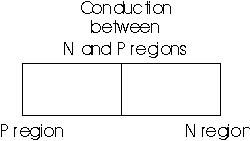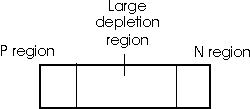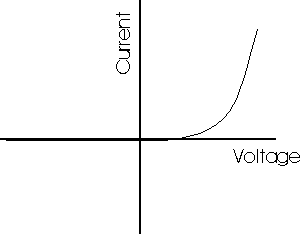Semiconductor PN Junction
- the basis of the semiconductor diode
One of the fundamental structures within semiconductor technology is the
PN junction. It is the fundamental building block of semiconductor diodes
and transistors and a number of other electronic components. It has the
valuable property that electrons only flow in one direction across it and as
a result it acts as a rectifier. As it has two electrodes it receives its
name - diode. In view of this, it is one of the most fundamental structures
in semiconductor technology. Vast numbers of diodes are manufactured each
year, and of course the PN junction is the basis of many other devices apart
from diodes. The bipolar junction transistor, junction FET and many more all
rely on the PN junction for their operation.
PN Junction
In its basic form a PN junction is formed from a piece of silicon by making one
end P type and the other end N type. This means that both ends have different
characteristics. One end has an excess of electrons whilst the other has an
excess of holes. Where the two areas meet the electrons fill the holes and there
are no free holes or electrons. This means that there are no available charge
carries in this region. In view of the fact that this area is depleted of charge
carriers it is known as the depletion region.

The semiconductor diode PN junction with no bias
applied
Even though the depletion region is very thin, often only few thousandths of
a millimetre, current cannot flow in the normal way. Different effects are
noticed dependent upon the way in which the voltage is applied to the junction.
If the voltage is applied such that the P type area becomes positive and the N
type becomes negative, holes are attracted towards the negative voltage and are
assisted to jump across the depletion layer. Similarly electrons move towards
the positive voltage and jump the depletion layer. Even though the holes and
electrons are moving in opposite directions, they carry opposite charges and as
a result they represent a current flow in the same direction.

The semiconductor diode PN junction with forward bias
If the voltage is applied to the PN junction in the opposite sense no current
flows. The reason for this is that the holes are attracted towards the negative
potential that is applied to the P type region. Similarly the electrons are
attracted towards the positive potential which is applied to the N type region.
In other words the holes and electrons are attracted away from the junction
itself and the depletion region increases in width. Accordingly no current
flows.

The semiconductor diode PN junction with reverse bias
Characteristics
The PN junction is not an ideal rectifier diode having infinite resistance in
the reverse direction and no resistance in the forward direction.

The characteristic of a diode PN junction
In the forward direction (forward biased) it can be seen that very little
current flows until a certain voltage has been reached. This represents the work
that is required to enable the charge carriers to cross the depletion layer.
This voltage varies from one type of semiconductor to another. For germanium it
is around 0.2 or 0.3 volts and for silicon it is about 0.6 volts. In fact it is
possible to measure a voltage of about 0.6 volts across most small current
diodes when they are forward biased. Power rectifier diodes normally have a
larger voltage across them but this is partly due to the fact that there is some
resistance in the silicon, and partly due to the fact that higher currents are
flowing and they are operating further up the curve.
From the diagram it can be seen that a small amount of current flows in the
reverse direction (reverse biased). It has been exaggerated to show it on the
diagram, and in normal circumstances it is very much smaller than the forward
current. Typically it may be a pico amps or microamps at the most. However it is
worse at higher temperatures and it is also found that germanium is not as good
as silicon.
This reverse current results from what are called minority carriers. These
are a very small number of electrons found in a P type region or holes in an N
type region. Early semiconductors has relatively high levels of minority
carriers, but now that the manufacture of semiconductor materials is very much
better the number of minority carriers is much reduced as are the levels of
reverse currents.
Summary
Even though the basic diode PN junction may appear to have limited applications,
it finds uses in a great variety of applications. Specialised versions of the
diode are used for particular applications. The light emitting diode (LED) and
photodiode are but two examples. However the PN junction is also the basis of
the bipolar junction transistor, and the junction FET. There are also many many
other examples of its use. As a result many billions of the PN junctions are
manufactured each year, and it is the most fundamental structure to today's
semiconductor electronics scene.
|

